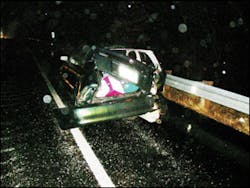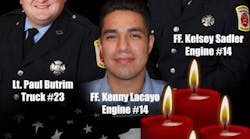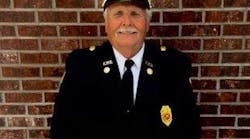There are many ways we can work to reduce firefighter injury and death. And it is clear that “we” keep getting hurt or killed in the same ways. Of course, among our ranks were firefighters who died in the line of duty for genuine and true heroics. No question. But, on the other hand, so many of us have been injured or worse due to tragic events that could have been clearly avoided. Unfortunately, we are generally slow to accept change on our job and therefore the same bad stuff keeps happening.
There are some fire departments and officers within those fire departments that have learned what has happened to “that other” fire department and due to firefighter safety and survival being a top priority, make changes without excuse. These fire departments and their members are focused on not “letting history repeat itself” at their department. It’s just a matter of how badly the fire department and its firefighters, company officers and chiefs want every member to come home after every run.
Firefighters being struck by vehicles is a big issue – and it keeps happening. Some fire departments have clear and strict policies that apparatus must block and protect the scene to protect members working. A good policy must be developed with the understanding that the police also benefit from this.
We don’t usually identify fire departments in this column, but several departments have written to us recently and are willing to openly share their stories. That is a refreshing approach-as volatile as it can be at times.
This month, we are going to look at two near-tragic events that occurred involving the City of Dover, NH, Fire & Rescue Department and one that occurred in Ohio as I was writing this column. Our sincere appreciation goes out to Chief Perry Plummer and the members of Dover Fire, and especially Captain David “Mac” McClean for his outstanding cooperation in the preparation of this month’s column. Also, thanks to the officers and members of the Deerfield Township, OH, Fire Department for their assistance regarding their recent close call that occurred at the time of this writing (see page 30).
This account is provided by Captain McClean:
Much has been published over the past few years about the highway dangers our fire and rescue responders face daily. The City of Dover Fire & Rescue Department heard the warnings loud and clear and began implementing safety procedures in an attempt to avoid having one of our firefighters become a statistic.
By way of background, Dover Fire is under the command of Fire Chief Perry Plummer and operates out of two fire stations covering an area of 27 square miles. The population is approaching 30,000. The city experiences a daily population increase with several large employers located within the city. The fire department is staffed on a daily basis with eight firefighters and two officers. The Central Fire Station responds with a three-person engine company and a two-person advanced life support (ALS) transport ambulance. The South End Fire Station responds with a three-person engine company and a two-person truck company operating a 102-foot tower ladder. Personnel work a 42-hour week on a 10/14 schedule. Last year, the department responded to 5,000 calls for emergency services.
After reading about fire departments experiencing tragic incidents on the roads and highways, we did some research to determine how we should best protect our members. Changes that were instituted included requiring all personnel to wear ANSI vests over their bunker gear, running our medium-duty rescue on all highway calls to use as a scene-protecting blocker, new vehicle placement procedures and other policies designed to protect fire personnel. These changes were coupled with an increase in awareness training for all personnel. All personnel are required to read all line-of-duty death reports as soon as they are released and the reports are then discussed at the coffee table. Our members also follow Firehouse® Magazine’s Close Calls column, Firehouse.com for daily firefighter news events and FirefighterCloseCalls.com for training and serious focus on firefighter safety and survival. All of this keeps personnel at Dover Fire from growing complacent. It also offers the department the opportunity to examine how these deaths might be avoided in the future.
The following is an overview of events that occurred on the highway in the early evening of Jan. 2, 2005, when our training and preparation paid off. It was a typical cold, winter day in Dover. The predicted forecast was cloudy and cold with frozen precipitation expected in the late afternoon or early evening. Dover Fire responded to our usual array of medical emergencies, public assists and accidents. The day-shift personnel went about their daily routine of housework, apparatus and equipment checks. As the sun began to set, rain began to fall on the cold ground. The area roads were turning into instant ice skating rinks!
At 2:16 P.M., Engine 4, Rescue 1, an ALS transport ambulance, and Squad 14, a medium-duty squad, were dispatched to 61 Spruce Lane for a vehicle that had struck a utility pole. Spruce Lane is located in a well-traveled residential area. Upon arrival, we observed that the force of the vehicle had split the pole in half, sending all the utilities falling to the ground.
Lieutenant Joseph Fortier assumed command and requested that the utility company, Public Service Company of New Hampshire, be notified and to expedite its response to the scene. The sole victim of the accident was removed and transported to the local hospital. The scene was not secure from traffic, so Engine 4 and Squad 14 remained on scene to prevent any civilians or vehicles from coming into contact with the downed utilities until the power company arrived.
Running through the westerly side of Dover is the Spaulding Turnpike. This is a well-traveled two-lane highway serving as the main route for tourists to reach the northern part of the state. Travelers that evening seemed unaware of the conditions being created by the freezing rain on the highway.
Our communications center began receiving numerous calls for vehicles off the turnpike. The on-coming shift was beginning to arrive for the night shift and the spare engine, Engine 6, was dispatched along with Rescue 2 to the southbound Spaulding Turnpike on the Rochester town line. The lieutenant on Engine 6, Randy Provencher, contacted the communications center and advised of the icy road conditions, and that it would take some time to reach the scene. Squad 14 was available from the earlier scene and was responding. While enroute to the scene, Squad 14 encountered an additional vehicle accident northbound and requested Engine 5 and Rescue 1 to respond. Squad 14 remained on scene as a blocker and to provide assistance to the vehicle occupants. Engine 5 experienced icy road conditions and proceeded at a reduced speed.
As usual, this did not deter cars from passing the apparatus on either side while responding to the scene. At some distance from the scene, we attempted to control the vehicles behind us by taking both lanes. As we have learned in our training, drivers are not paying attention, and our concern was that someone would strike us when we stopped at the scene. We arrived on scene and positioned our engine at a 45-degree angle to the guard rail and blocked the traveling lane about 300 feet from the scene, pursuant to our standard operating guideline (SOG). We exited the vehicle on the guardrail side and the operator exited once the traffic was halted and we proceeded to the scene on the inside of the guardrail. We assisted the squad with the patients. As no one needed to be transported, we signed them off. Due to the high numbers of vehicles off the road, we were advised that tow trucks would be delayed for removal.
The decision was made to keep the individuals in our apparatus and off of the highway to avoid anyone being struck. The Engine 5 crew was returning to their apparatus when a vehicle traveling in the traveling lane apparently did not see the accident scene and hit the rear of the engine on the driver’s side, sending his vehicle into the guardrail opposite the engine. Traffic stopped momentarily. The occupant exited the vehicle and we had to stress to him the need to stay off the highway! He indicated that he had no injuries and we notified the communications center of our circumstance and reported no injuries.
By now, traffic had stopped and the vehicle was guided to a location in front of Engine 5 until the arrival of state police. Traffic was still passing the scene with what we considered a high rate of speed for the conditions. We kept our distance on the opposite side of the guardrail.
While we were operating at this scene, Engine 4 was on the opposite side of the highway about a mile north experiencing the same road conditions and vehicle problems. To their advantage, the accident vehicle had taken up most of the road requiring them to close the road, backing up traffic for at least five miles.
At Engine 5’s scene, the crews continued to work and wait for the arrival of the tow trucks. At this time, the crew could see a vehicle approaching the scene in the blocked lane. Apparently, the driver did not see the accident scene and all the flashing lights. The car began to spin as the driver hit the brake. Within seconds, the spinning vehicle struck the back of the blocking Engine 5. For the second time in just over one hour, our pumper had been struck. This accident resulted in totaling the vehicle that struck the pumper.
We immediately stopped all traffic, began to render aid and notified the communications center of the accident. This time, the officer’s side of the engine sustained a majority of the damage. The female patient was examined and, remarkably, did not require medical treatment. The trooper on scene performed a field sobriety test, which she failed, and she subsequently was arrested.
There were a few factors that we feel contributed to these accidents. First and foremost was the weather. The time of day was also a factor. With a dark and rainy highway, visibility was poor. The New England Patriots had just won a big game; therefore, many people were returning from football parties, including the driver involved in the second accident. These events and factors are not foreign to responders anywhere in the United States.
There is no question in our mind that had it not been for the safety procedures developed and adhered to, we would have lost one of our brothers or sisters. Most of our “lessons learned” came prior to this night, affording us our more successful outcome. The following represents some of these “lessons learned”:
- We discussed as a department what we could do to prevent our people from becoming statistics on the roadway.
These comments are based on Chief Goldfeder’s observations and communications with the writer and others regarding this incident:
It is clear after reading this account and talking to the members of Dover Fire that the priority is the safety and survival of its members. Many fire departments and fire department leaders talk about firefighter safety, but not all “walk the walk,” so to speak. It doesn’t take more than a little while visiting almost any fire department on a scene or at their station to determine whether the top priority at that fire department is to have every member come home after every run.
A few hints can include:
- Seatbelt use, meaning that the apparatus doesn’t budge until the officer knows everyone is belted in.
Of course, those are just a few areas that can be used to “measure” how a fire department will function before and during a run. There are many, many more. This month, specifically, we are focusing on our operations on the roads and highways. Readers of this column are urged to take a few minutes and check out: http://www.lionvillefire.org/hwy_safety/ or go to www.LionvilleFire.org and click on “Highway Incident Safety for Emergency Responders.” This is part of the website operated by the Lionville Fire Company in Pennsylvania. This specific section is written by well-known public safety instructor Jack Sullivan and focuses on the tragic loss of one of its members on the Pennsylvania. Turnpike. However, it also has numerous resources available online to help prevent our members from being struck while operating on the roadways. This site is well worth your time.
Any of us working along roadways run the risk of being struck by a motorist. To prevent such incidents, the National Institute for Occupational Safety and Health (NIOSH) recommends that fire departments and firefighters take the following actions:
Fire departments:
- Develop, implement and enforce standard operating procedures (SOPs) regarding emergency operations for roadway incidents. Just like at a fire, we need to pre-plan what we will do when we approach, arrive and operate.
Firefighters:
- Ensure that fire apparatus is positioned to take advantage of topography and weather conditions (uphill and upwind) and to protect firefighters from traffic. We have a choice: some lunatic motorist striking firefighters, police and civilians – or striking apparatus. Dover Fire taught us this one above.
Take a few moments to determine whether the near-tragic events described this month could occur to your fire department. Of course, the answer is yes. The bigger question is to determine whether all of your members are aware of and trained for these kinds of responses. It is also critical to determine whether clear and trained-upon policies and procedures exist.
But the biggest question is (and it always is): Are the safety and life saving related standard operating procedures (SOPs) and standard operating guidelines (SOG) at your fire department strictly enforced by the company officers? If not, none of this matters at your fire department and the end results are predictable.
Firefighters Protect Themselves at Interstate Highway Crash Scene
Moments later, a motorist struck the fire apparatus that was intentionally blocking and protecting the working area of the scene. The crash damaged the apparatus and injured the striking motorist. Even though the road had not been shut down, the firefighters followed their fire department’s procedure by blocking the road and protecting the scene. Clearly, those actions by the fire officers and fire apparatus operators saved their own and others lives, including the police. Interestingly, even after the second crash, the road was not shut down by police on the scene.
—William Goldfeder







